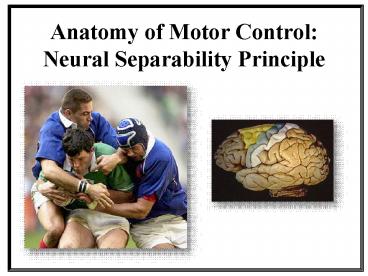Anatomy of Motor Control: Neural Separability Principle PowerPoint PPT Presentation
1 / 36
Title: Anatomy of Motor Control: Neural Separability Principle
1
Anatomy of Motor Control Neural Separability
Principle
2
Early Exploration of Central Contributions to
Control Wilder Penfield
From http//www.psych.ualberta.ca/GCPWS/dswmedia/
Wilder20Penfield.mov
3
Simplified View of the Motor System
Taken from http//www.utdallas.edu/tres/integ/mo
t1/motor_1.html
4
Divisions of the Motor System Functions
Taken from http//www.utdallas.edu/tres/integ/mo
t1/motor_1.html
5
Orientation of Anatomical Sites
6
Important Neural Substrates for Motor Control
- Higher Centers
- Dorsolateral Prefrontal Cortex
- Posterior Parietal Cortex
- Premotor Area
- Supplementary Motor Area
- Motor Cortex
- Basal Ganglia
- Cerebellum
- Spinal Contributions
- Interneurons
- Effectors
- Motor Units
- Peripheral Sensory Contributions to Control
- Proprioceptors
7
Dorsolateral Prefrontal Cortex
- is assumed to be important in working memory and
executive function--including the regulation of
thinking and action. Damage to this region
provokes dysexecutive syndrome.
8
Posterior Parietal Cortex
- The parietal cortex receives somatosensory,
proprioreceptive, and visual inputs, then uses
them to determine the positions of the body and
the target in space. It thereby produces internal
models of the movement to be made, prior to the
involvement of the premotor and motor cortices.
9
Premotor Motor Region
10
Motor Areas and Function
11
Basal Ganglia
12
- Basal Ganglia
- Very Complex Structure
- Many Projections
- Important Inhibitory Role
- Does not directly activate Mn
13
Early Signs and Symptoms of Parkinsons Disease
- Cardinal Characteristics
- Resting tremor
- Bradykinesia
- Rigidity
- Postural instability
- Other
- Micrographia
- Masked face
- Slowing of ADLs
- Stooped, shuffling gait
- Decreased arm swing when walking
14
Cerebellum
15
Cerebellum Inputs
16
Cerebellum Outputs
17
Cerebellum
- Coordination and smoothness
- Internal Clock
- Learning and automation
- NOT initiation
18
The Motor Cortex Somatotopic Topography
19
M1 Organization
- topographic map describes an organizational
scheme in which neuronal connections preserve the
relative organization of cells between two
regions - somatotopic organization maps that reproduce the
anatomy of the human body on a small scale
20
Simplified View of the Motor System
Taken from http//www.utdallas.edu/tres/integ/mo
t1/motor_1.html
21
(No Transcript)
22
Three Primary Methods supporting Neural
Separability Principle
- Lesion work
- Animal and Human models
- Virtual Lesioning using TMS
- Neural Imaging (we will examine later)
23
Lesion Work Cerebellum
Food for Thought For the longest time the
thinking was that cerebellar lesions were most
evident when performing more complex skills. In
the present work consider which task is most
difficult with respect to (a) number joints being
used, (b) torques being controlled, or the
spatial demands of the task.
24
Timing and Cerebellum
TT
CC
IC
Spencer et al., (2003). Science, 300 1437-1439
25
Cerebellum Timing
- What are dependent variables?
- What are the independent variables?
- What is your hypothesis?
- Displacement, Mean Duration, Standard Deviation,
CoV - Health Status, Continuity of Task
Spencer et al., (2003). Science, 300 1437-1439
26
Timing and Cerebellum
TT
IC
CC
Spencer et al., (2003). Science, 300 1437-1439
27
Transcranial Magnetic Stimulation (TMS)
28
Transcranial Magnetic Stimulation (TMS) Uses
- Interruption of ongoing neural activity to assess
functional localization - Visual cortex
- SMA
- Motor Cortex
- Cortical Physiology
- Conduction speed delays and locus of delays
- Brain Plasticity Verifying structural change
- Therapeutic Use (see later)
- Slow rTMS (1 Hz) increase inhibition
- Fast rTMS (gt 5 hz) increases excitability
29
Conduction speed delays and locus of delays
(Abductor digiti minimi)
SIMILAR
TMS
TIME
30
Brain Plasticity Left amputee at elbow
RIGHT M1 for eliciting left bicep MEP
LEFT M1 for eliciting right bicep MEP
From Hallett, 2000 Nature
31
Pascual-Leone, A. et al. (1995)
JOURNALOFNEUROPHYSIOLOGY , 74(3), 1037-1045
32
TMS Therapeutic Use
- Parkinsons Disease
- Writers Cramp (dystonia)
- Epilepsy
- Stroke Recovery
- Various psychiatric disorders
33
Transcranial Magnetic Stimulation (TMS)
Advantages
- Can be conducted with normal subjects thus
removing the possible confound of additional
lesions - Can be performed acutely without involvement of
neural plasticity or re-organization - TMS can be repeated with same subject thus
introducing possibility for appropriate controls - Multiple subjects can be subjected to identical
lesions thus increasing statistical power - Can target different brain regions with same
subject to more precisely describe behavioral
disruptions - Can execute the TMS with many different tasks to
look at specificity issues
Pascual-Leone et al., 1999, Phil. Trans. R. Soc.
Lond.
34
TMS Cerebellum
pft paced finger tapping
Theoret et al., (2001). Neuroscience Letters,
306 29-32.
35
Behavioral Findings
LC lateral cerebellum MC medial Cerebellum
MT site of motor threshold Sham
reorientation of TMS
Theoret et al., (2001). Neuroscience Letters,
306 29-32.
36
Motor System Summary

